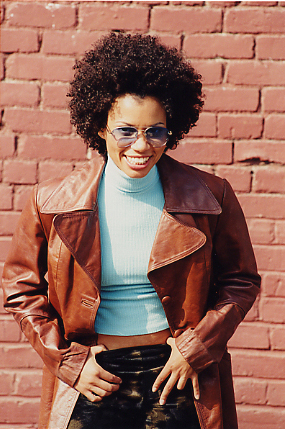Originally from Toronto, Canada, Kai Soremekun started her career as an actress in New York City. Her many credits include the films “Heat”, “Regarding Henry” and a series regular role on the FOX Television drama “Medicine Ball”. Kai recently finished production on the 20 episode first season of her interactive web series CHICK. The show, created by and starring Kai, is about a woman who sets out on a quest to realize her dream of becoming a superhero. CHICK has been featured in The Washington Post and received an Indie Soap Award for best directing.
Read Part 1 here.
Now things get really exciting! In part one, we talked about changing your mindset to that of a star and developing projects. Now we’re going to make your project and start you on the road to actually being a star.
There are four steps to getting your project out in the world.
1. Pre-production, where you prepare all the elements you’ll need to shoot your script.
2. Production, the actual shooting of your script.
3. Post-production, where you take your raw footage from the shoot and turn it into a finished film.
4. Distribution, getting the finished film out into the world for people to see your creative brilliance.
In this post we’re going to talk about the first three steps.
PRE-PRODUCTION
The Script
Hopefully all that work you put in during development has resulted in an awesome script you can’t wait to shoot. Make sure your script is tight and shoot ready before you move forward. As the saying goes, you can’t make a bad script into a good film.
$
Your budget affects every choice you make moving forward. There are two ways to go about determining your budget.
Go through your script and start doing research to see how much things will cost to shoot. This is where an experienced producer comes in handy (see below). If you don’t have anyone on your team with production experience, use logic. For example you’ll need a camera. Do you have a friend with a camera who might let you borrow it for the shoot? If not, call a rental house and get a quote. Are there any items in the design of your set or wardrobe that will need to be purchased? Price them out. You get the idea. Do the research, add up the numbers and see what you get.
The other option is to pick an amount you want to spend and find a way to make your script within this set budget. I funded the first season of CHICK myself so I knew how much money I had and adjusted accordingly. Working within a set budget often requires some out of the box creativity in order to realize your vision. In our second episode I had the lead character jumping off the side of a building. We obviously couldn’t shoot her really doing that so we shot still photos of her doing various flips and then superimposed these over a shot of a building. You can check out how we did it in this behind the scenes video. Hopefully this will show you that with a little bit of out of the box thinking, you can create some cool visuals even with minimal funds.
The ways to raise money are only limited by your creativity, so have fun. Remember you’re a star pitching you and your project. Be passionate and excited when you talk about it. The more you believe in your project, the more others will be willing to invest in your vision.
Even if you want outside sources to fund your project, I’m a big believer that you should invest some of your own money in your film. Think about it. Why should someone else invest in your film if you’re not willing to?
One cool option to consider, is signing up with a crowd-funding website. These sites let you sign-up for a free account and create a project profile where you can direct people to invest in your film. Two of the most popular sites are Kickstarter.com and Indiegogo.com.
Key Crew
Since this is a starring vehicle for you the next thing you need to do is find a producer. Yes, you will be credited as a producer too. Yes, you will be involved in all decisions made throughout production. However, when you start shooting, you’ll need someone else who has answers to the myriad of questions that come up during production so you can stay focused on just being an actor and delivering that brilliant performance.
Find the most experienced producer you can. Don’t let lack of funds stop you from approaching people with way more experience than you. Passion for what you want to do goes a long way in getting people excited to be a part of your film.
If you can’t find someone with producing experience ask a friend to help out. This should be a person who is skilled at multi-tasking, organization, remains calm under pressure, and communicates well with people. This person can make or break your production so be sure it’s someone you trust and get along with.
Next you’ll want to bring on your director. They will be realizing your vision from the creative stand point. Again you want someone who communicates well with people. They are the leader on set and help guide everyone to carry out their responsibilities. This is also the person you will be working most closely with as an actor so make it someone you trust and feel comfortable with. Make sure the vision they have for your piece is the same as yours. The director will then be involved in hiring your other key crew such as the director of photography and the production designer.
Prepare, Prepare, Prepare
Pre-production is the time to find answers to as many production questions as possible. Time becomes very expensive once you’re on set. You’ve rented equipment, solidified locations, organized your cast and crew. You’re going to need every minute to shoot this baby and get it in the can so minimize lengthy discussions on set by planning as much as possible pre-shoot.
You should have at least one pre-production meeting with key crew. This would include, at minimum, the producer, director, production designer and director of photography. As the director, I like to go through the script page by page, making comments on my vision for each scene and answering any questions my keys have. This also allows the producer to start figuring out how the vision is going to be implemented from a logistics stand point.
Double or triple the amount of time you think it will take you.
Everything always takes longer than expected so schedule accordingly. Clint Eastwood is known for coming in under budget and ahead of schedule. At a Q&A he did after one of his films he was asked how he consistently did that. The simple answer, he padded his budget and his schedule. If he thought scenes at a specific location would take three days he’d say it would take him four. So follow Clint’s lead. Even if you can’t pad your production days because of budget you can pad your pre-production to make sure you’ve covered all the bases and you’re prepared going into shooting.
PRODUCTION
Lights, Camera, Action
There are lots of things to take care of during the actual shoot but that’s the job of your producer and the rest of the crew. Your job once on set is to let go of everything else and focus on your performance. The best way to make sure this is possible is to clarify with your producer beforehand that as soon as you’re on set you don’t want to be a part of production decisions. Hopefully you took my advice previously and brought someone on as your producer that you completely trust. Your soul job on set is to be relaxed and immersed in the character you are playing.
Food
One final note on production. Because most independent shoots are low budget, this means most, if not all, of your cast and crew are working for free. Always, always, always show deep appreciation for the talented people giving of their time and talent for your project by feeding them well. Meals and craft service are often the biggest line item on my budgets because if I can’t pay you I want to make sure your tummy is always full on my set. A well fed crew is a happy crew who will go out of their way to help you realize your dream.
If you can, find other ways to show love for your cast and crew. I met a masseuse at an event I was attending just before we were getting ready to shoot CHICK. I told him about the project and he offered to come on set and give mini-massages gratis. We scheduled him to come down on the last day of shooting and during lunch everyone who wanted one got a massage. I can’t say it enough. Constantly find ways to show your cast and crew love. People like to be appreciated.
POST PRODUCTION
Whew! Okay you’ve made it through production. That’s a big mountain you just climbed over so give yourself a pat on the back.
Plan For Post Production
A lot of films come out of production but never become finished films because they didn’t plan for post production. Be sure to dedicate a chunk of your budget to post production. Your key people in post will be your editor and sound designer.
Great sound design has a huge impact on the quality of your film. Finding a good sound designer who is willing to work for free is difficult. So, this is an area I recommend allocating some of your budget to.
If you’ve heard the saying every film gets made three times, once by the writer, once by the director and once by the editor, then you know having a good editor on board is also very important. As the star of the piece you are going to have to step back into your producer role and find a way to distance yourself from your performance so you can help the editor and director make choices that best serve the overall story of your film. I edited CHICK and found I was able to edit my own performance by looking at the character as someone else other than me.
Editing is where you have to put the telling of your story first. Yes that shot where you’re beautifully backlit looks awesome, but if it doesn’t move your story forward, be willing to cut. Be ruthless in making this a priority.
I’d suggest you start thinking about music during pre-production. Introduce yourself to up and coming indie musicians that have music styles you think would work well with your film. Establish relationships with them. Then when you’re ready, you can approach them to see if they’d be willing to let you use a track. This will also pay off when you start putting your film out into the world. They’ll be happy to promote your project to their audience if they have a song in your film.
Lean On Your Support
When you’re into post production, you’re likely to be tired. It’s a lot of work getting a film made. To help keep you going, rely on your producer, good friends and family to keep your energy up. Have them give you frequent pep talks. Support is hugely important in making your dream a reality. The finish line is in sight, do everything you can to get there.
In the final installment of this series we’ll talk about distribution and the ways to get your film out into the world. For now, have fun making those films.
Here’s a great resource to check out: 50 Best Websites for Moviemakers


























[…] This post was mentioned on Twitter by Kai Soremekun, chickspirit and Kai Soremekun, Brains of Minerva. Brains of Minerva said: How to be a Star, pt. 2 is up! @kaisorekum walks us through the steps to self-produce http://bit.ly/9JyVde […]
[…] You get a hand clap! If you’ve followed the advice in parts one and two of this series then you’ve got a finished film in your hands. That is a huge deal, so […]
[…] Kai Soremekun on How to Be a Star Part 2 […]